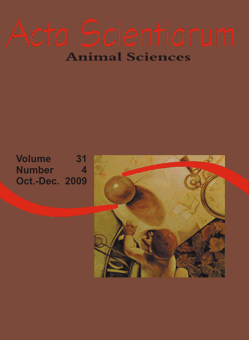<b>Replacing corn with cassava starch by-products on the performance, digestibility and carcass characteristics of bulls in confinement</b> - DOI: 10.4025/actascianimsci.v31i4.6093
Keywords:
co-product, cattle, performance, carcass quality
Abstract
The effects of replacing corn with different levels of cassava starch by-products (0, 12.5, 22.8, and 32.7%) were evaluated on performance, digestibility and carcass traits of feedlot bulls. Thirty-two crossbred bulls (½ Nelore x ½ Angus) around 18 months of age and 380 kg of body weight were used. A completely randomized design was used, with 4 treatments and 8 replicates. Evaluated traits were: average daily gain (ADG), carcass dressing (CD), backfat thickness (BT), Longissimus area (LDA), leg length (LL) and cushion thickness (CT), dry matter intake (DMI), feed conversion ratio (FCR), total apparent digestibility of dry matter (DMDC), organic matter (OMDC), crude protein (CPDC), crude energy (CEDC), acid detergent fiber (ADFDC) and neutral detergent fiber (NDFDC). The experiment was developed during a period of 56 days, after 14 days of adaptation. No differences were observed for BDG, CY, FCR, BT, LDA, LL, and CT results did not present differences (p > 0.05) among the treatments. DMI presented linear decrease as corn was replaced by cassava starch by-products. The digestibility coefficients of DM, OM, CP, CE, NDF and ADF did not vary among the experimental rations.Downloads
Download data is not yet available.
Published
2009-10-30
How to Cite
Dian, P. H. M., Prado, I. N. do, Fugita, C. A., Prado, R. M. do, Valero, M. V., & Bertipaglia, L. M. A. (2009). <b>Replacing corn with cassava starch by-products on the performance, digestibility and carcass characteristics of bulls in confinement</b> - DOI: 10.4025/actascianimsci.v31i4.6093. Acta Scientiarum. Animal Sciences, 31(4), 381-387. https://doi.org/10.4025/actascianimsci.v31i4.6093
Issue
Section
Ruminant Nutrition
DECLARATION OF ORIGINALITY AND COPYRIGHTS
- I Declare that current article is original and has not been submitted for publication, in part or in whole, to any other national or international journal.
The copyrights belong exclusively to the authors. Published content is licensed under Creative Commons Attribution 4.0 (CC BY 4.0) guidelines, which allows sharing (copy and distribution of the material in any medium or format) and adaptation (remix, transform, and build upon the material) for any purpose, even commercially, under the terms of attribution.
Read this link for further information on how to use CC BY 4.0 properly.
0.9
2019CiteScore
29th percentile
Powered by 








































